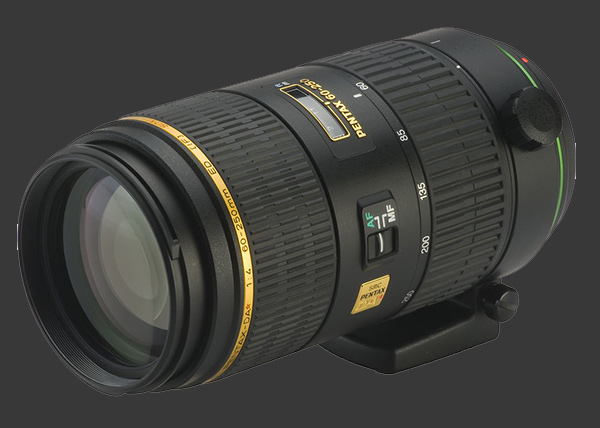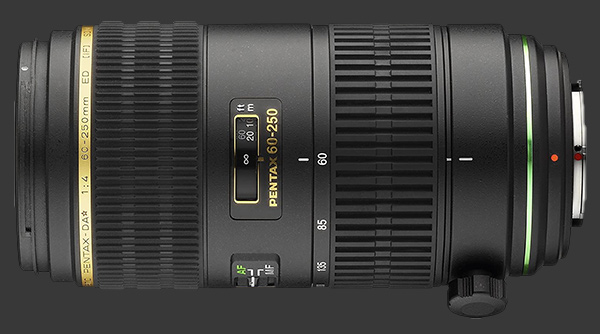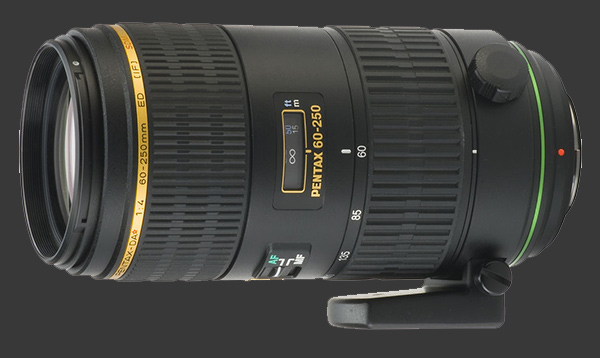Pentax DA* 60-250mm F/4 SDM Review
Introduction
The Pentax DA* 60-250mm F/4 SDM is a professional-grade telephoto zoom lens for APS-C DSLRs. This lens covers a wider range than the majority constant-aperture zoom lenses. In fact, it offers the highest optical zoom ratio of any constant-aperture telephoto lens. If an equivalent Full-Frame lens were to exist, it would have a 90-375mm focal-range.
The Pentax DA* 60-250mm F/4 SDM was added to the DA* series in late 2008, making it the fourth lens in this premium lineup. As all other DA* lenses, this telephoto is fully weatherproof and freezeproof. It is designed specifically for use on a DSLR with an APS-C sensor, allowing to create this long reach while minimizing bulk. This is also the fourth lens with the infamous SDM focus motor. Luckily, it has a screw-drive focus-link too.

This was the longest premium lens offered by Pentax at the time. Its reach is highly desirable for sport and street photography but it is too large and heavy for the latter. Given its 1kg weight, the DA* 60-250mm F/4 SDM was not very popular and it became a more of a specialty lens.
This telephoto zoom lens captures a 6.5-26° angle-of-view that can isolate distant subjects and heavily compress perspective. Its moderate aperture which stays constant all the way to 250mm is useful to capture moving subjects. Even though it is labeled SDM, the Pentax DA* 60-250mm F/4 SDM also features screw-drive autofocus.
Design & Build Quality
The Pentax DA* 60-250mm F/4 SDM has a unique optical design tuned to deliver the highest-quality images from an APS-C DSLR at the time. The result is a dense lens with an internal focus system packed inside a weatherproof and freezeproof body. This is very sturdy lens with weight to match.
Its body is mostly a large cylinder with 8cm diameter until it becomes one centimeter narrower at the lens mount. At its widest focal-length, it is almost 17cm long. An inner barrel extends out another 8cm when zoomed in all the way to 250mm. Both the outer and inner barrels are very sturdy and fit tightly together.
There is a nice smooth finish on exposed parts of the lens barrel. A large textured focus-ring at the front of the lens mechanically controls the focal-plane. It has a 30° throw from the minimum focus-distance of 1.1m to slightly passed infinity. The focus-ring continues to rotate beyond this range without affecting the focal-plane. Closer to the camera body, there is a wide zoom ring with deeper texture. This ring rotates with some resistance through its 90° throw which avoids any zoom creep.

A simple AF/MF switch on the side of the lens barrel has a nice firm detent. On top of the lens along the barrel ring that as the focus-switch, there is a focus-window that shows the currently set focal-length. Unlike with some designs, the focus-distance shown is always accurate since it changes in both AF and MF modes.
This is the first DA* lens with tripod support. It has an original design to attach a tripod adapter to the base of a rotating collar. The adapter and collar are separate and only the adapter detaches. This makes it highly efficient to install and remove while allowing the lens to be used in different orientations when mounted on a tripod.
Pentax fit their DA* 60-250mm F/4 SDM with a KAF2 lens mount which offers mechanical aperture and focus links, plus electronic contacts that control aperture and focus using the SDM motor. Autofocus defaults to the SDM system, unless the camera only has a KAF mount. It is possible to modify the firmware to always select screw-drive autofocus though.

Dual autofocus systems inside the Pentax DA* 60-250mm F/4 SDM were intended to allow a smooth transition from traditional screw-drive autofocus lenses to modern ultra-sonic ones. This shows how much Pentax was interesting their existing customer-base. It also saved them from a potential fiasco when SDM motors started failing at an alarming rate, particularly first-generation ones. These SDM motors frequently died after only a few years yet the screw-drive link stood the test of time. It also allowed for faster AF when fitted on newer cameras.
The front of the lens accepts 67mm screw-on filters. This is one of the most common and affordable filter sizes among all brands. Pentax created a custom petal lens hood for this lens with a large removable window. Once removed, this window gives access to the lower edge of the mounted filter which is extremely convenient when mounting a polarizer that requires rotating.
Image Quality & Autofocus Performance
Pentax designed a new optical formula for the DA* 60-250mm F/4 SDM to match the ultimate resolution at the time and provide room for higher-resolutions in the future. Back in 2008, Pentax DSLR just jumped from 10 to 15 MP. The result is a lens that produces legendary results with contemporary cameras and remains reasonable on modern 26 MP DSLR that capture 70% more resolution!

It is significantly easier to produce a telephoto lens than a wide-angle one without distortion. Unsurprisingly, the DA* 60-250mm F/4 SDM shows virtually no discernible distortion at any focal-length. Also completely absent from images at any aperture is vignetting. The geometry of this lens is exemplary.
Optically, this constant-aperture telephoto zoom offers a similar yet slightly superior performance than the DA* 50-135mm F/2.8 SDM launched one year earlier. Much performance characteristics are comparable but contrast notably improved with the DA* 60-250mm F/4 SDM. This lens is extremely resistant to flare and chromatic aberrations. Purple fringing is also a rare occurrence.
Pentax DA* 60-250mm F/4 SDM Sharpness
Excellent sharpness is achievable with this lens when stopped down sufficiently. There is much less variation in sharpness in relation to focal-length than with other DA* lenses, although output is slightly better towards the longer half of the focal-range. Near the wide end, there is generalized softness from edge-to-edge which improves by stopping down. Around F/6.7, everything is acceptably sharp and at F/8 the entire image becomes completely sharp.
Towards the middle of the range, there is some definite softness across the frame yet it is minimal near the center. Closing the aperture to F/4.5 makes the center sharp and improves corners. Only a half-stop more at F/5.6 does the entire image become sharp from edge-to-edge. Stopping down further to F/6.7 and F/8 incrementally sharpens the image. Diffraction starts taking effect around F/13.
The extreme telephoto focal-length of this lens shows similar qualities than the middle. The entire image has a slight softness at F/4 and this improves at F/4.5 with a greater improvement near the center. F/5.6, just one stop down from wide-open on this lens, captures sharp images. To maximize corner-to-corner sharpness, it is necessary to stop down to F/6.7.
What is shown below are 5 crops taken from a photograph, repeatedly captured for each combination of focal-length and aperture. The smaller pieces are cropped from the extreme corners of the image, while the middle wide crop comes from the center of the image. Select an aperture in a row for a desired focal-length to see the crops from the corresponding image. When judging quality, keep in mind that these crops come from a 26 MP image which is normally used to print an image up to 30x20". On a computer display, these may appear much larger which magnifies image defects.
The above interactive crops clearly show the progression from generalized softness to fully image sharpness according to aperture. The good news is that images can be sharp from corner to corner when stopped down 1.5 stops from wide open. There is a slight bias towards the long end of the zoom yet this difference has little impact on typical print sizes.

Autofocus Performance
This is a repetition of the analysis of first-generation SDM motors encountered in the DA* 16-50mm F/2.8 SDM and DA* 50-135mm F/2.8 SDM. Only launched a year later, this lens does not show any reliability improvement with its SDM motor. It has a tendency to fail which is why the backup screw-drive autofocus system saved the series.
Autofocus speed of this lens is highly variable. It can focus quite quickly when the SDM motor responds well but this is not always the case. The screw-drive system is much more reliable. It is a little slower but never stalls completely. This lens can handle tracking subjects with medium speed.
Conclusion
The Pentax DA* 60-250mm F/4 SDM is very capable of capturing superb images even though it was designed more than 14 years ago. Its unique focal-range and high-quality optics make it well-suited to capture distant subjects, even in moderately low light, thanks to its constant maximum aperture.
Image quality from this lens is very good once stopped down only one stop from its widest. Sharpness is completely acceptable throughout the frame at F/5.6 and is exceptional at F/6.7 and beyond. Wider aperture show general softness which is more pronounced at extreme corners.
There is essentially nothing to say about vignetting or distortion, either are simply not there. Color, contrast, flare and chromatic aberrations are also extremely well controlled. Optically, this is a pretty good lens. This zoom is also extremely tough and has an outstanding weatherproof and freezeproof body.
Autofocus can be quick yet the builtin SDM motor is unreliable. Luckily, it is possible to reprogram the firmware of this lens to operate by screw-drive autofocus which delivers a much more consistent experience. It is fractionally slower than when the SDM motor responds well but infinitely better when it stalls.
Pentax makes for constant-aperture telephoto lenses, each with its own advantages. The DA* 50-135mm F/2.8 SDM is the oldest yet also the smallest and lightest. Next up is the Pentax HD D FA 70-210mm F/4 SDM WR that shifts the focal-range further while giving up a full-stop of brightness. This is the most probable lens other lens to consider since it is only135g heavier. It definitely leaves a gap between either DA* 16-50mm F/2.8 lenses and itself but so is the case for the two remaining contenders. Next up is another old lens which is unfortunately also prone to SDM failure, the Pentax DA* 60-250mm F/4 SDM. At 200g heavier, this 60-250mm lens has the widest focal-range in the group. Finally, if weight is not a consideration, there is the Pentax HD H FA* 70-200mm F/2.8 DC AW which weighs 70% more while offering Full-Frame coverage.
The Pentax DA* 60-250mm F/4 SDM delivers the largest zoom ratio for a constant-aperture telephoto lens, regardless of brand or mount. This makes it highly versatile for capturing subjects at various distances, even as light levels diminish. Its image quality is sufficiently good for most usage simply by stopping down one stop from wide open. The lens is very sturdy and exceptionally well built. Even though its SDM autofocus motor is not entirely reliable, a secondary screw-drive motor allows it to recover from an SDM failure. Nothing with telephoto coverage in the Pentax APS-C lineup compares to the DA* 60-250mm F/4 SDM.

Please Support Neocamera
All information on Neocamera is provided free of charge yet running this website is a huge endeavor. Purchases made via affiliate links found throughout the site help keep it running and up-to-date. There is no additional cost to you, so please consider buying via these links to our affilates:
If you found any information on this site valuable and did not purchase via our affiliate links, please considering donating via PayPal:
Any amount will be greatly appreaciated. Thank you for your support!
Updates
2025.01.18

Fujifilm GFX 2025 Lens Roundup
Lens Review roundup of Fujifilm GFX Medium-Format lenses. Quality, performance and handling of the GF20-35mm F/4R WR, GF30mm F/3.5 Tilt-Shift and the GF55mm F/1.7.
2024.11.18

Best 2024 Photography Gifts for Every Budget
Great gifts for photographers and photo enthusiasts selected for every budget among the best products of 2024.
2024.08.07

Eye Protection Tips for Professional Photographers
The four main considerations for professional photographers regarding eyewear.
2024.07.14

Fujifilm X100VI Review
Flagship fixed-lens compact digital camera with a 40 MP sensor and Image-Stabilization, a first for the series. Retro design featuring dual control-dials, plus direct ISO, Shutter-Speed and EC dials. Its hybrid viewfinder can switch between EVF and OVF mode.
2024.05.09

Fujifilm GFX100 II Review
Flagship 102 Megapixels Medium-Format Mirrorless Digital Camera with 8-Stop 5-Axis IBIS, 8 FPS Drive, 8K Video and 400 MP Super-Resolution capture in a weatherproof and freezeproof body with dual control-dials and dual memory-card slots.
2024.04.03

Fujifilm X-T5 Review
Newest Fujifilm flagship boasting a 40 MP APS-C sensor, 5-axis IBIS with 7-stop efficiency, 15 FPS continuous drive, 6.2K Video capture, dual control-dials and dual SDXC UHS-II slots in a sturdy weatherproof and freezeproof body.
2023.11.20

Best Digital Cameras of 2023
Find out which are the Best Digital Cameras of 2023. All the new Mirrorless Digital Cameras from entry-level to high-end professional.
2023.07.10

Fujifilm X-H2 Review
40 Megapixels APS-C Hybrid Mirrorless Digital Camera with 7-stop IBIS. Fastest shutter ever and 8K video capture. Large builtin EVF with 0.8X magnification and 5.8 MP, plus an Eye-Start Sensor. Packed with features and large number of controls in a weatherproof and freezeproof body.
2023.05.07

Sony FE 20-70mm F/4G Review
Review of the unique Sony FE 20-70mm F/4G lens. The optical zoom of this lens spans ultra-wide-angle and medium focal-length coverage, making it one of the most versatile Full-Frame lenses on the market.
2023.01.15

Huion Inspiroy Dial 2 Review
Review of the Huion Inspiroy Dial 2 tablet, a medium sized drawing surface with dual dials and customizable buttons. Connects via USB-C or Bluetooth 5.0 with Windows, Linux and Android support.
2022.12.08

How to Pack for a Photo Trip
Find out how to pack for a travel photography trip, carry your gear safely while meeting airline regulations.
2022.11.13

Best Digital Cameras of 2022
The best digital cameras of 2022. A short list of the most outstanding models in their respective categories. Choose one for yourself or as a gift.
2025.01.18
2024.11.18
2024.08.07
2024.07.14
2024.05.09
2024.04.03
2023.11.20
2023.07.10
2023.05.07
2023.01.15
2022.12.08
2022.11.13
NEWS
2025.03.26

Canon Launches Pair of Cameras and Lenses
Digital Camera ○ Lens
2025.03.25

Venus Optics Launches Vista Vision Cine Lenses
Lens
2025.03.24

Think Tank Photo Walker Pro
Bag
2025.03.20

Fujifilm First Fixed Lens Medium-Format Camera
Digital Camera
2025.02.26

Sony Launches Two New Lenses at CP+2025
Lens
2025.02.25

CP+2025 Showcases Numerous Launches
Digital Camera ○ Lens
2025.02.13

Nikon Launches 5X Full-Frame Power-Zoom Lens
Lens
2025.02.05

Nikon Refreshes Flagship Ultra-Zoom
Digital Camera
2025.02.05

Nikon Launches Ultra-Bright 35mm F/1.2 Prime Lens
Lens
2025.01.21

Fujifilm Evolves INSTAX Wide
Digital Camera
2025.01.16

Leica Launches SL3-S
Digital Camera
2025.01.14

Think Tank Photo Launches Dark Light Tactical Backpacks
Bag



















